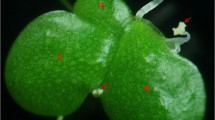Abstracts
Mungbean (Vigna radiata (L.) Wilczek) is a self-pollinating crop that displays significant hybrid vigor in seed yield of F1 hybrids. Thus there is the possibility to use hybrid varieties as a breakthrough to raise the yield plateau of mungbean. However, hybrid mungbean seeds can only be accomplished by hand-pollination and thus commercial production is not possible. To encourage hybrid seed set, the plant breeder needs to develop characters that promote higher outcrossing rate such as open flower (chasmogamy). In this experiment, new chasmogamous mutants were induced by gamma irradiation at the rate of 100 and 200 Gy. The mutants were identified at a low rate of 0.4–0.7% in the M2 generation of accession V1197, and observed for their purity by growing in plant-to-row in the M3 and M4 generations. A uniform chasmogamous line was hybridized to normal flower lines to study the inheritance of this character. All F1 plants had normal flowers, while the F2 plants segregated well with 3 normal : 1 chasmogamous ratio. When the F1 was backcrossed to the chasmogamous parent, the progeny gave a ratio of 1 normal to 1 chasmogamous. Thus, chasmogamy was controlled by a single recessive gene, cha.


Similar content being viewed by others
References
Azzini LE, Rutger JN (1982) Amount of outcrossing on different male steriles of rice. Crop Sci 22:905–907
Chen X, Sorajjapinun W, Reiwthongchum S, Srinives P (2003) Identification of parental mungbean lines for production of hybrid varieties. Chiang Mai Univ J 2:97–105
Cherian CA, Nalini M, Deepak J, Saxena KB (2006) Open flower segregants selected from Cajanus platycarpus crosses. Int Chickpea Pigeonpea Newsl 13:32–33
Douglas AC, Freyre R (2010) Floral development, stigma receptivity and pollen viability in eight Nolana (Solanaceae) species. Euphytica 174:105–117
Gupta PK (1996) Mutation breeding in mungbean. In: Asthana AN, Kim DH (eds) Proceedings of recent advances in mungbean research. Indian Society of Pulses Research, Kanpur, pp 124–136
Herridge DF, Robertson MJ, Cocks B, Peoples MB, Holland JF, Heuke L (2005) Low nodulation and nitrogen fixation of mungbean reduce biomass and grain yields. Aust J Exp Agric 45:269–277
Hual-alai N, Srinives P, Sorajjapinun W, Reiwthongchum S (2000) Effect of gamma radiation on variation of progenies from crosses between cultivated and wild mungbean. In: Proceeding National Mungbean Research Conference VIII. Kasetsart University, Nakhon Pathom, 18–20 Jan 2000, pp 31–40
Mao CX, Virmani SS, Kumar I (1998) Technological innovations to lower costs of hybrid rice seed production. In: Virmani SS, Siddiq EA, Muralidharan K (eds) Advances in hybrid rice technology. International Rice Research Institute (IRRI), Manila, pp 111–128
Mather K (1951) The measurement of linkage in heredity. Methuen & Co, London
Sangsiri C, Sorajjapinun W, Srinives P (2005) Gamma radiation induced mutations in mungbean. ScienceAsia 31:251–255
Santos IS (1969) Induce of mutations in mungbean (Phaseolus aureus Roxb.) and genetic studies of some of the mutants. In: Induced mutations in plants. IAEA, Vienna, pp 169–179
Singh VP, Sharma R (1993) γ-Rays-and EMS-induced leaf mutants in mungbean (Vigna radiata (L.) Wilczek). Curr Sci 65:636–638
Soehendi R, Srinives P (2005) Significance of heterosis and heterobeltiosis in an F1 hybrid of mungbean (Vigna radiata (L.) Wilczek) for hybrid seed production. SABRAO J Breed Genet 37:97–105
Virmani SS (1994) Heterosis and hybrid rice breeding. Monographs on theoretical and applied genetics 22. International Rice Research Institute (IRRI), Manila
Virmani SS, Athwal DS (1973) Genetic variability in floral characteristics influencing outcrossing in Oryza sativa L. Crop Sci 13:66–67
Wu X (2009) Prospects of developing hybrid rice with super high yield. Agron J 101(3):688–695
Yadav RDS, Singh VP (1987) Induce male sterile mutant in green gram. Curr Sci 56:419
Yuan LP (1987) The strategic idea on hybrid rice breeding. Hybrid Rice 1:1–3
Yuan LP (1997) Hybrid rice breeding for super high yield. Hybrid Rice 12(6):1–6
Yuan LP (1998) Hybrid rice development and use: innovative approach and challenges. Int Rice Comm Newsl 47:7–15
Acknowledgments
The authors thank the Project on Biotechnology for Varietal Development of Thai Mungbean, Thailand’s National Science and Technology Development Agency and Center for Advanced Studies in Agriculture and Food, Kasetsart University for financially support this research.
Author information
Authors and Affiliations
Corresponding author
Rights and permissions
About this article
Cite this article
Sorajjapinun, W., Srinives, P. Chasmogamous mutant, a novel character enabling commercial hybrid seed production in mungbean. Euphytica 181, 217–222 (2011). https://doi.org/10.1007/s10681-011-0408-z
Received:
Accepted:
Published:
Issue Date:
DOI: https://doi.org/10.1007/s10681-011-0408-z




